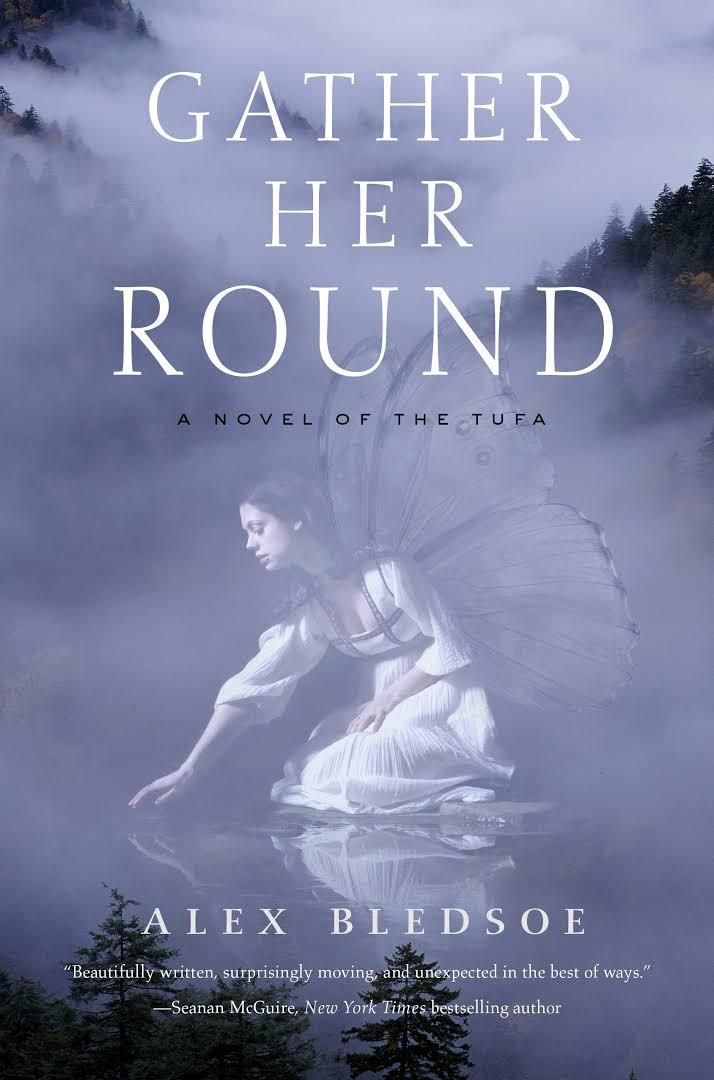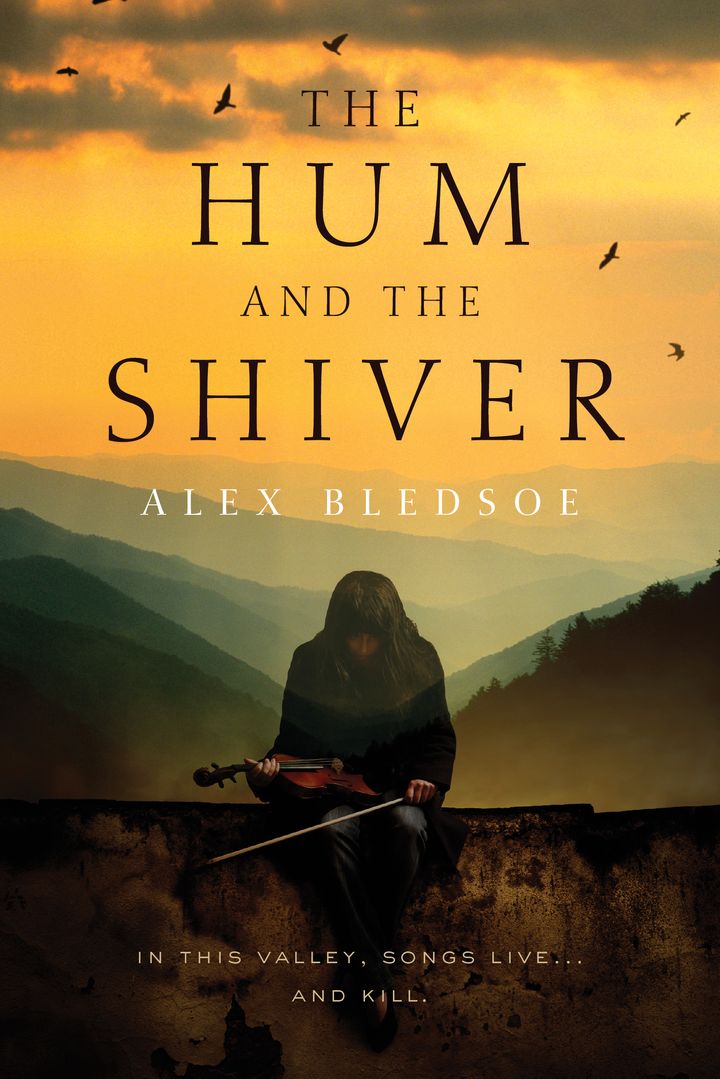In the heart of America resides an age-old culture, rooted in music and faerie magic. That is the central theme of Alex Bledsoe’s elegantly-written and passionate Tufa series, which begins with The Hum and the Shiver. The latest installment, Gather Her Round, combines elements of murder, jealousy and revenge that characterize songs going back centuries—here playing out in a small Appalachian town in Tennessee. Music pervades these novels, acting alternately as a weapon and a source of epiphany. It is so central to the series that the author even had a song specially composed for this latest book.
I caught up with Alex to talk about the origins of the Tufa, the myths that infuse their music, and much more.

What was your inspiration for the Tufa? I spotted elements from Celtic mythology, and also possibly Roma—how off base am I? And how does this tie in to the landscape of Appalachia?
My father’s family came from the area around Jonesborough, Tennessee (also home to the National Storytelling Festival, which figures in Gather Her Round). My dad would talk about this group of people who lived in the mountains near the Kentucky border and were supposedly here when the first settlers arrived. He also characterized them very similarly to the way the Roma were regarded in European history, but he was passing down what he’d heard. Of course it wasn’t true; it was just another manifestation of that fear of otherness that drives so much southern culture.
But the bit that stuck was the idea of a group of unknown origin, who were already here when the Europeans showed up. That concept sat in the back of my mind for over thirty years, until it finally clicked together with some other ideas and became the first Tufa novel, The Hum and the Shiver.
Music is integral to the novels and to the culture of the Tufa. How would you describe the relationship of your novels to music, and do you have preferred types?
In the context of the novels, the Tufa manifest their faerie magic via music, and use its power to influence the world at large. Thematically, I use song lyrics to comment on the action, and to set that action in a larger and more universal context. Music is wonderful for that. Most human interactions—love, hate, jealousy, tenderness, rage, joy—are expressed much more eloquently by songs than mere words. When you tell someone, “I’m lonely,” they might sympathize, but when Hank Williams sings, “I’m So Lonesome I Could Cry,” then they feel it.
More personally, despite a few attempts when I was younger, I’m not a musician. If, as Harlan Howard said, music is “three chords and the truth,” then I know two chords and some gossip. So to me, the songwriting process is actual, real-world magic. I mean, hell: in the song “Copperhead Road,” Steve Earle tells the story of three generations of the Pettimore family in less than five minutes. A writer doing the same thing would need hundreds of pages. That’s sorcery.

When choosing songs for the books, I use two main sources: traditional ballads (which have the virtue of being public domain) and songs by independent musicians. Those ballads came over with the Europeans and stayed here, unchanged, until the beginning of the modern era. As for indie artists, they tend to both own all their rights, and understand the value of being quoted in a book. So it’s win-win.
If I can’t find the right song using those methods, then I’ll write lyrics myself. Not actual songs: usually they’re just snippets, designed to convey the idea of a song. I use an approach suggested by a musician friend: write the lyrics to a tune you already know, but never tell anyone what that tune is. That way the words scan like those of a real song.
Interestingly, the new Tufa novel, Gather Her Round, required a song that would serve a very specific narrative purpose, and I could neither find an existing song that worked, or come up with anything myself. So for the first time, I asked some musician friends (the Lucky Nows) to write an original song for the book. They did a great job, the song is in the book, and will also be on their forthcoming album.
Each novel of the Tufa is self-contained, but it’s also a tile in a much larger mosaic. What are your plans for the series?
The overall theme of the series is: when it’s no longer possible to hide from the world, how do you make your peace with it? The Tufa have stayed in their little valley forever, content to be ignored. But now the world reaches everywhere, even there; what do you do then? It’s not the kind of theme that ever really reaches a resolution, so there’s no over-arching outline. As long as people want to read them, I’ll keep writing them.
Since it’s a series based around a place, there’s a core cast of characters who grow, change and occasionally die. A protagonist in one book might be a supporting character in the next. As you said, each story stands alone, but if you do read them in order, you’ll see a progression, and hopefully an extra sense of reality.
To what extent did you set out to create a mythology that is uniquely American? Or would it be a mistake to see it that way, given the Celtic influences?
A: The novels take place mostly in Appalachia, which was settled by the Irish and Scots. In fact, if you go back far enough into prehistory, when all the continents were joined, the mountain chain that became the Appalachians is part of the same one that became the Scottish Highlands. It’s one reason Scottish settlers took to that part of America so well: it reminded them of home. So at its base, it’s the same mythology.
Just look at the way Elizabethan songs were retained, virtually verbatim, by mountain families. When folklore researchers known as “song catchers" ventured into the mountains at the turn of the twentieth century, they found families singing original versions of songs not heard anywhere else in two hundred years. The extreme isolation, both from Europe and from other people in the mountains, kept those songs pure. And it’s the same way with many elements of folk belief: if it applied in the new world, it was retained.
However, this is the modern South, where there’s a rich mythology of the “Old South” overlaid on these Celtic beliefs. They’re not mutually exclusive, and in fact they inform each other in fascinating ways, and create a distinctive belief system. I didn’t deliberately set out to create a mythology, but if I have, I suppose it would be uniquely American because of those origins.

Can you name some authors who inspire you?
Gosh, so many. I got into writing via the great detective authors: Chandler, Hammett, Robert B. Parker, Andrew Vachss. Raymond Carver taught me that there were stories all around in mundane life. In fantasy, Charles de Lint and Emma Bull basically created the genre I work in, and if you read de Lint’s Memory and Dream and Bull’s War for the Oaks, you’ll see it. I’m a huge fan of Ekaterina Sedia, who writes fantasy from a very distinctive background of Russian folklore. And I’m friends with far too many great, under appreciated authors to list here, because I’d be too afraid I’d leave somebody out.

Alex Bledsoe grew up in west Tennessee an hour north of Graceland (home of Elvis) and twenty minutes from Nutbush (birthplace of Tina Turner). He’s been a reporter, editor, photographer and door-to-door vacuum cleaner salesman. He now lives in a Wisconsin town famous for trolls and tries to teach his three kids to act like they’ve been to town before. His latest novel is Gather Her Round.
*
Ilana Teitelbaum has written about books for the Globe and Mail, the Los Angeles Review of Books, Salon, and other places. Her epic fantasy debut, Last Song Before Night, was released by Tor/Macmillan in 2015. The sequel, Fire Dance, is forthcoming in 2018.
